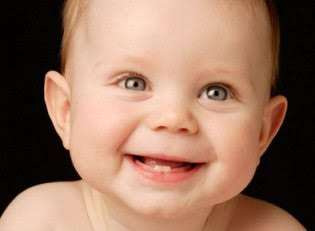You’ve made it through the sleepless newborn nights, and you’re finally settling into a schedule, only to be confronted by your next parenting challenge: teething.
Teething and its profound effect on young children comes as a big surprise to unaware parents, so read on for the basics you’ll need to know.
While teething can begin as early as 4 months of age, most babies don’t begin to teethe until 6 months. Your baby’s lower central incisors, the two front teeth on the bottom, are the first to arrive between 6 and 10 months. Next up are the upper central incisors, which appear between 8 and 12 months. The upper lateral incisors, just to either side of the central incisors, may emerge between 9 and 13 months. The lower later incisors are usually close behind at between 10 and 16 months. Then we begin to see molars. The first molars are just in front of the molars found at the very back of the mouth, the uppers appearing between 13 and 19 months. The lower first molars come in between 14 and 18 months.These molars can be painful for your child, since they are breaking through a large area of gum tissue. And the tough days are not over once these come in, as your child’s canine teeth are next. These are the pointy teeth between the lateral incisors and the first molars. These can cause pain due to the length of time it takes for them to come in, and the fact that they must break through larger amount of gum tissue the further they emerge. Your child’s upper canines come in between 16 and 22 months, and the lower canines may follow between 17 and 23 months. The last baby teeth, the second molars, at the very back of the mouth, appear between 23 and 31 months on the bottom and 25 and 33 month on top. Because kids of this age are better communicators, you might find that the second molars are a bit easier to handle, as your child can ask for a teether, a cold drink, or medicine, to help the pain.
Your child’s teething symptoms depend on a variety of factors, including her pain tolerance, how quickly her teeth emerge, and her temperament. Some children manifest very few symptoms while teething, while others suffer from fussiness and fitful sleep. Babies can be especially fussy for the few days preceding a tooth’s eruption, as swelling and soreness is particularly tough in those days. Many babies start to gnaw on everything they see, from fingers to blankets to toys. And babies often drool much more than usual when teething. Watch for excessive drooling as it can lead to a rash due to chapped skin. Babies may run a low grade fever due to the inflammation in their gums, or may wake up a few times per night because of discomfort.
If your baby is exhibiting teething symptoms, you’ll want to help her find relief. Help to numb and soothe your baby’s gums by putting a teething toy or a wet washcloth in the refrigerator. The cold sensation, and the pressure from chewing, will help with teething pain. If you’ve stumbled on a perfect teething toy for your child, remember to buy an extra for your daycare staff to use during the weekdays. One parent we know pureed watermelon and froze it into popsicles for a cold teething treat. Some parents advocate frozen bagels or chunks of fruit, but keep an eye on your child when he is chewing on items like this, as they may pose a choking hazard. Does your baby still seem fussy and irritable? Ask your pediatrician to recommend the proper dose of Tylenol or Advil, as over the counter pain relief is sometimes just the trick, especially at night. Be cautious of teething gels, which can numb your baby’s throat, and have been warned against by the FDA.
Parents of toddlers and preschoolers, can you help out our first time moms and dads with your advice? What worked best for your child when teething? Let us know in the comments!

